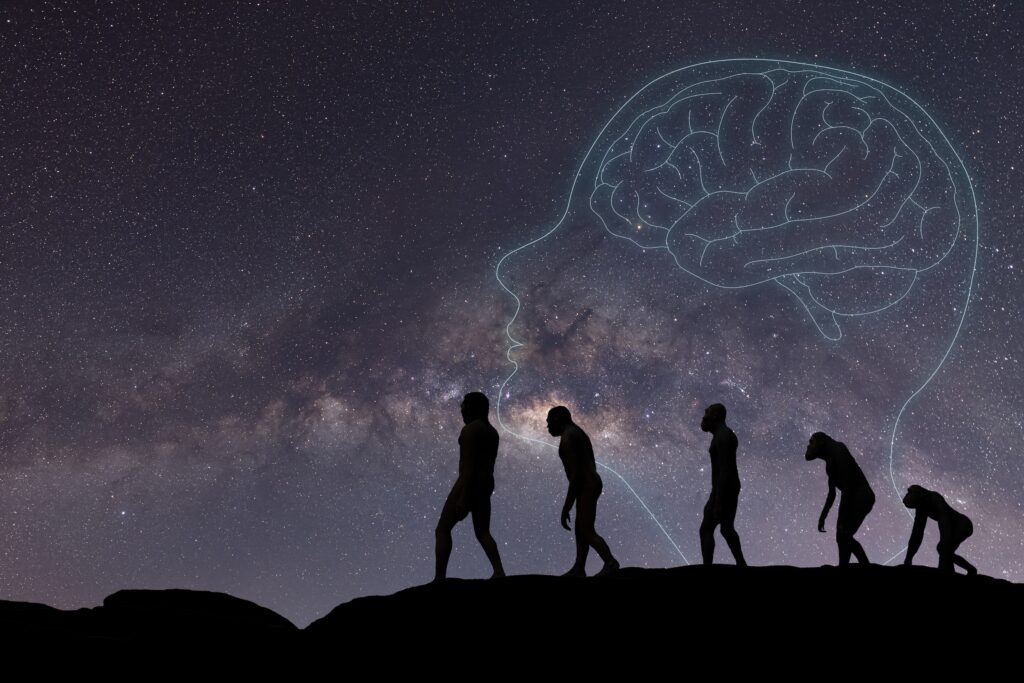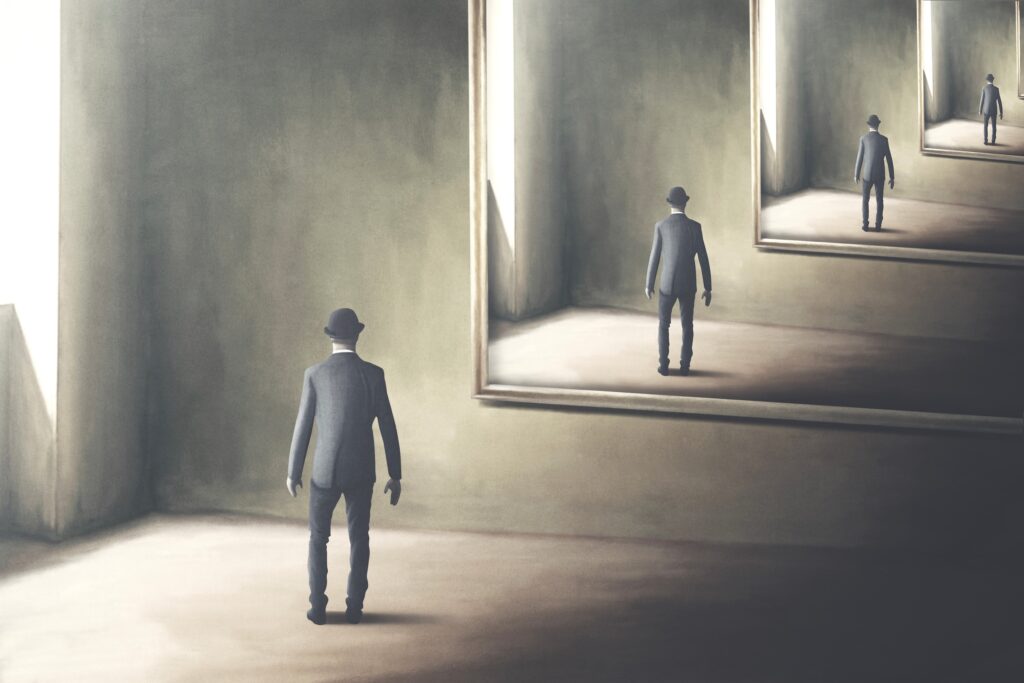How can you be me? The answer is time
Reading | Philosophy
![]() Bernardo Kastrup, PhD, PhD | 2022-05-06
Bernardo Kastrup, PhD, PhD | 2022-05-06

That you believe you were your five-year-old self is grounds to believe that you can be another person, right now, while still being you, argues our executive director in this stimulating theoretical essay.
How can one universal subject be you, and me, and everybody else, at once? This is perhaps the most difficult aspect of analytic idealism to wrap one’s head around, for it implies that you are me, at the same time that you are yourself. How can this possibly be? After all, you can see the world through your eyes right now, but not through mine.
Although reference to dissociative disorders, empirically validated as they are, forces us to accept that such somehow can indeed be the case—for it is the case in severely dissociated human minds—the question of how to visualize the dissociation remains difficult. How can you visualize a process by virtue of which you are me while being yourself concurrently? How are we to get an intuitive handle on this?
Notice that what makes it so difficult is the simultaneity of being implied in the hypothesis: you can easily visualize yourself being your five-year-old self—an entity different from your present self in just about every way—because being your five-year-old self is not concurrent with being your present self: one is in the past, the other is in the present. Visualizing oneself taking two different points of view into the world does not offer any challenge to our intuition, provided that these points of view aren’t taken concurrently.
Here is an example. When I was a child, I used to observe a very curious behavior of my father’s: he would play chess against himself, a common and effective training technique in a time before computerized chess engines. Doing so helps a chess player learn how to contemplate the position on the board from the opponent’s point of view, in order to anticipate the opponent’s moves. My father would perform this exercise quite literally: he would play a move with the white pieces, turn the entire board around by 180 degrees, and play a move with the black pieces. Then turn the board back to white again, and so on.
My father—a single subject—was taking two different points of view into the world, experiencing the battle drama of the game from each of the two opposing perspectives; one subject, two points of view. We have no difficulty understanding this because the two perspectives weren’t simultaneous, but instead occupied distinct points in time.
Yet, we’ve known for over a century now that time and space are aspects of one and the same thing: the fabric of spacetime. Both are dimensions of extension in nature, which allow for different things and events to be distinct from one another by virtue of occupying different points in that extended fabric. For if two ostensibly distinct things occupy the same point in both space and time, then they can’t actually be distinct. But a difference in location in either space or time suffices to create distinction and, thereby, diversity. By occupying the same point in space, but at different times, two objects or events can be distinguished from each other; but so can they be distinguished if they exist simultaneously at different points in space.
The way to gain intuition about how one subject can seem to be many is to understand that differences in spatial location are essentially the same thing as differences in temporal location. This way, for the same reason that we have no difficulty in intuitively understanding how my father—a single subject—could seem to be two distinct chess players, we should have no intuitive difficulty in understanding how one universal subject can be you and me: just as my father could do so by occupying different perspectives at different points in time—that is, by alternating between black and white perspectives—the universal subject can do so by occupying different perspectives at different points in space; for, again, space is essentially the same thing as time.
Yet, the demand for this transposition from time to space still seems to be too abstract, not concrete or intuitively satisfying enough; at least to me. We need to make our metaphor a little more sophisticated.
A few years ago, I had to undergo a simple, short, but very painful medical procedure. So the doctors decided to give me a fairly small dose of a general anesthetic, which would knock me out for about 15 minutes or so. I figured that that would be a fantastic opportunity for an experiment: I would try to focus my metacognition and fight the effects of the drug for as long as I could, so to observe the subjective effects of the anesthetic on myself. I had undergone general anesthesia before, in my childhood, but had no recollection of that, so this was a fantastic chance to study my own consciousness with the maturity and deliberateness of an adult.
And so there I was, lying on an operating table, rather excited about my little experiment. The drug went in via the IV and I focused my observation of the contents of my own consciousness, like a laser. Yet, as the seconds ticked by, I couldn’t notice anything. “Strange,” I thought, “nothing seems to be happening.” After several seconds I decided to ask the doctors if it was normal for the drug to take so long to start causing an effect. Their answer: “We’re basically done, just hang on in there for a few more moments so we can wrap it up.”
“WHAT?” I thought. “They are basically done? How can that be? It hasn’t been a minute yet!” In fact, more than 15 minutes had already elapsed; they had already performed the whole procedure. I experienced absolutely no gap or interruption in my stream of consciousness; none whatsoever. Yet, obviously there had been one. How could that be? What had happened to my consciousness during the procedure?
The drug altered my perception of time in a very specific and surprising way. If we visualize subjective time as a string from where particular experiences—or, rather, the memories thereof—hang in sequence, the drug had not only distorted or eliminated access to some of those memories, but also cut off a segment of the string and tied the two resulting ends together, so to produce the impression that the string was still continuous and uninterrupted. I shall call this peculiar dissociative phenomenon ‘cognitive cut and tie.’ The memory of certain experiences in a cognitively associated line are removed from the line, and the two resulting ends seamlessly re-associated together, so the subject notices nothing missing.
Now let us bring this to bear on my father’s chess game. Imagine that we could manipulate my father’s perception of time in the following way: we would cut every segment of time when my father was playing white and tie—that is, cognitively associate—these segments together in a string, in the proper order; we would also do the same for the black segments. As a result, my father would have a coherent, continuous memory of having played a game of chess only as white, and another memory of having played another—albeit bizarrely identical—game of chess only as black. In both cases, his opponent would appear to him as somebody else. If you were to tell my father that it was him, himself, on the other side of the board all along, he would have thought you mad. For how could the other player be him, at the same time that he was himself, playing against his opponent?
The answer to how one universal subject can be many—to how you can be me, as you read these words—resides in a more sophisticated understanding of the nature of time and space, including the realization that, cognitively speaking, what applies to one ultimately applies to the other. As such, if you believe that you were your five-year-old self, then there is an important sense in which, by the same token, you must believe that you can be me. There is only the universal subject, and it is you. When you talk to another person, that other person is just you in a ‘parallel timeline’—which we call a different point in space—talking back to you across timelines. The problem is simply that ‘both of you’ have forgotten that each is the other, due to dissociative ‘cut and tie.’
A different subjective position in space is just a different point in a multidimensional form of time, and vice-versa. Indeed, such interchangeability between space and time is a field of rich speculation in physics. Physicist Lee Smolin, for instance, has proposed that space can be reduced to time. Physicist Julian Barbour, in turn, has proposed the opposite: that there is no time, just space. There may be a coherent theoretical sense in which both are right.
The most promising theoretical investigation in this area is perhaps that of Prof. Bernard Carr, from Queen Mary University London, a member of Essentia Foundation’s Academic Advisory Board. If his project is given a chance to be pursued to its final conclusions, it is possible that physics will offer us a conceptually coherent, mathematically formalized way to visualize how one consciousness can seem to be many.
Looking upon personal identity through the lens suggested above may convince you that, when an old wise man turns to a brash young lad and says, “I am you tomorrow,” such statement may have more layers of meaning than meets the eye at first.

Essentia Foundation communicates, in an accessible but rigorous manner, the latest results in science and philosophy that point to the mental nature of reality. We are committed to strict, academic-level curation of the material we publish.
Recently published
Reading
Essays
Seeing
Videos
Let us build the future of our culture together
Essentia Foundation is a registered non-profit committed to making its content as accessible as possible. Therefore, we depend on contributions from people like you to continue to do our work. There are many ways to contribute.















